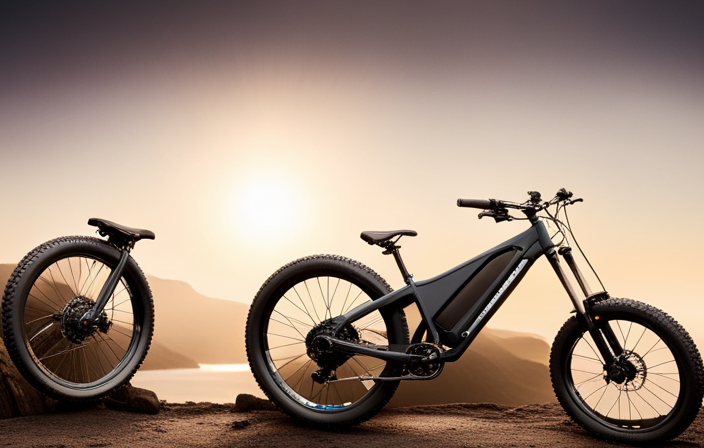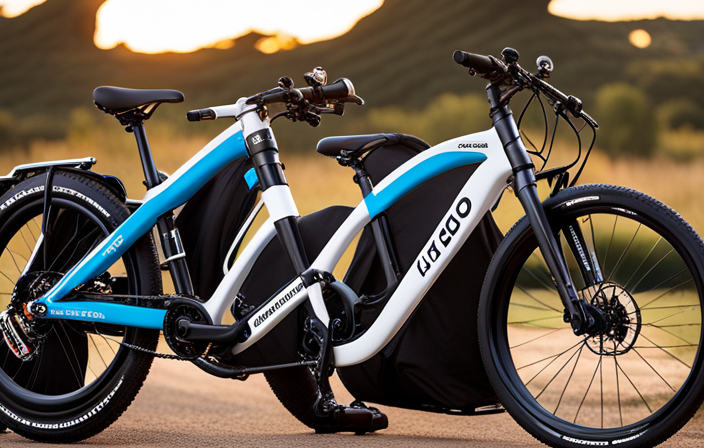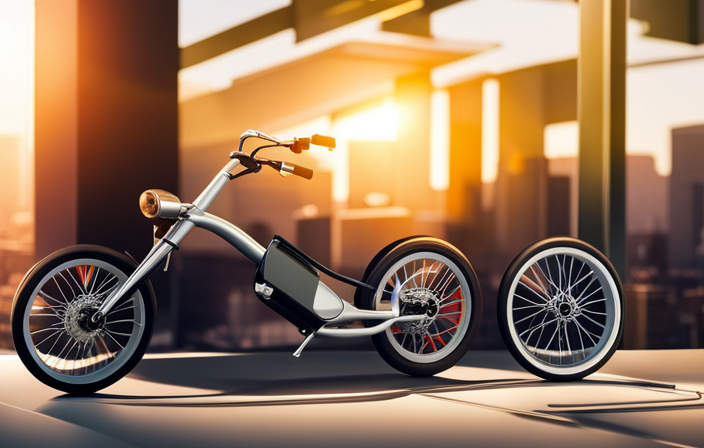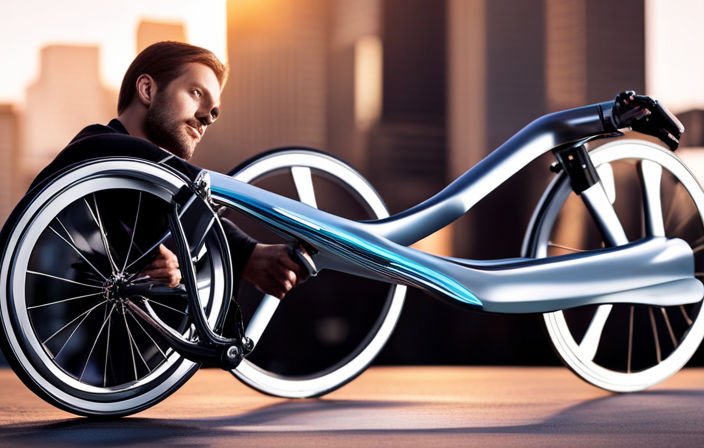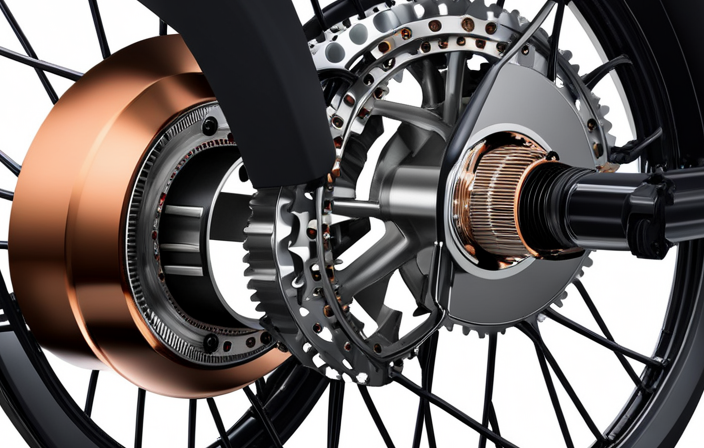Are you tired of pedaling up those steep mountain trails? Well, my fellow outdoor enthusiasts, fear not! In this article, we will delve into the age-old debate of gas-powered versus electric mountain bikes.
Get ready for some serious analysis as we compare performance, environmental impact, cost, and more.
So, whether you’re a thrill-seeking speed demon or an eco-conscious nature lover, join me as we explore the pros and cons of these two wheeled beasts.
Let the battle begin!
Key Takeaways
- Electric mountain bikes have a range of 30-60 miles, which may be a drawback for longer rides or challenging trails.
- Electric mountain bikes have better off-road capability, with lighter weight and precise control for different terrains.
- Be aware of legal restrictions and safety regulations, as regulations vary depending on jurisdiction and may include age restrictions and licensing requirements.
- Electric bikes have a lower carbon footprint compared to gas bikes, as they use renewable energy sources and emit zero emissions during operation.
Performance and Power Output
If you want more power and performance, you’ll find that an electric mountain bike is the better option. Electric bikes are known for their impressive power output, thanks to the electric motor. This allows riders to conquer challenging terrains and steep hills with ease.
Additionally, electric bikes provide a boost to your pedaling power, making it easier to ride for longer distances without getting tired.
From a cost-effectiveness standpoint, electric bikes can be more expensive upfront, but they can save you money in the long run. With an electric bike, you don’t have to worry about fuel costs, and maintenance is generally cheaper compared to gas-powered bikes.
Moreover, electric bikes have a lower environmental impact, as they produce zero emissions and reduce the reliance on fossil fuels.
Transitioning into the environmental impact section, let’s discuss how electric bikes contribute to a greener future.
Environmental Impact
Considering the environmental impact, you may want to evaluate the emissions and overall sustainability before making a decision.
When it comes to the long term effects, electric mountain bikes have a lower carbon footprint compared to gas-powered ones. Electric bikes produce zero emissions while in use, reducing air pollution and greenhouse gas emissions. Additionally, they have a lower impact on natural resources as they do not require fossil fuels to operate. This makes electric bikes a more sustainable choice for outdoor enthusiasts who want to enjoy nature while minimizing their environmental impact.
Furthermore, electric bikes are quieter, reducing noise pollution in natural areas.
Transitioning into the subsequent section about ‘cost and maintenance’, it is important to consider not only the environmental impact but also the financial implications of your choice.
Cost and Maintenance
When it comes to the cost and maintenance of these bikes, it’s important to factor in the financial implications of your choice.
Electric mountain bikes generally have a higher upfront cost compared to gas-powered ones. This is because electric bikes come with a battery and motor, which adds to their manufacturing expenses. However, when considering the long-term cost, electric bikes tend to be more cost-effective. They require less maintenance and have lower operating costs since they don’t require gasoline.
On the other hand, gas-powered mountain bikes may have a lower initial cost, but they require regular maintenance, including oil changes and tune-ups. Additionally, the cost of gasoline can add up over time.
Transitioning into the subsequent section about ‘noise level,’ it’s also worth noting that electric bikes are quieter than their gas-powered counterparts.
Noise Level
When it comes to the noise level of mountain bikes, there is a clear distinction between gas bikes and electric bikes.
Gas bikes tend to be louder and can potentially disturb wildlife and other outdoor enthusiasts.
On the other hand, electric bikes are much quieter, providing a more peaceful riding experience.
This is an important consideration for those who value the tranquility of nature and want to minimize their impact on the environment.
Gas bikes are louder and may disturb wildlife and other outdoor enthusiasts
Gas bikes are louder and may disrupt wildlife and other outdoor enthusiasts. When it comes to performance comparison, gas bikes tend to have more powerful engines, which results in higher noise levels. This can be a concern when riding in natural environments, as the loud noise may disturb wildlife and disrupt their natural habitats. Additionally, other outdoor enthusiasts such as hikers, runners, and horseback riders may also find the noise intrusive and unpleasant.
It is important to consider the impact on wildlife and respect the tranquility of nature while enjoying outdoor activities. On the other hand, electric bikes are quieter and provide a more peaceful riding experience. They emit minimal noise, allowing riders to enjoy the scenic views and connect with nature without causing disturbance.
Electric bikes are quieter and provide a more peaceful riding experience
Electric bikes offer a quieter and more serene riding experience. With their electric motors, they produce minimal noise, allowing riders to enjoy the peacefulness of nature without disturbing wildlife or other outdoor enthusiasts. The quietness of electric bikes creates a sense of tranquility, enhancing the overall riding experience.
To further understand the advantages of electric bikes in terms of quietness and tranquility, consider the following:
- Reduced noise pollution: Electric bikes emit little to no noise, providing a more enjoyable and peaceful environment for both riders and those around them.
- Enhanced wildlife encounters: The quiet operation of electric bikes allows riders to get closer to wildlife without startling or disturbing them.
Electric bikes not only offer a more peaceful riding experience, but they also provide accessibility and ease of use. They are user-friendly and suitable for riders of all ages and fitness levels.
Accessibility and Ease of Use
The accessibility and ease of use of both gas and electric mountain bikes are crucial factors to consider when making a decision. Electric mountain bikes are known for their user-friendly features. These include adjustable pedal assist levels and intuitive controls. These features make it easier for riders of all skill levels to navigate different terrains and enjoy a smooth and enjoyable ride.
Gas mountain bikes, on the other hand, require manual gear shifting and clutch control. These may be more suitable for experienced riders who are comfortable with these mechanics. However, electric mountain bikes offer adaptability for different skill levels. They allow beginners to gradually build their confidence while still providing a thrilling experience for advanced riders.
With these factors in mind, it is important to also consider the battery life and charging capabilities of electric mountain bikes. This will ensure uninterrupted adventures on the trails.
Battery Life and Charging
When it comes to battery life and charging, there are some key points to consider.
Gas bikes have the advantage of unlimited range, but they require frequent refueling, which can be a hassle.
On the other hand, electric bikes have a limited range, but they can be easily recharged at home or on the go, making them convenient for daily use.
It’s important to weigh the pros and cons of each option to determine which one best suits your needs and preferences.
Gas bikes have unlimited range but require frequent refueling
Gas bikes have an unlimited range, but they’ll need frequent refueling. When it comes to performance comparison and impact on outdoor recreation, it’s undeniable that gas bikes excel in terms of range. With their powerful engines and fuel tanks, they can take you on long adventures without worrying about running out of juice. However, this advantage comes at a cost. You’ll need to refuel regularly, which can be time-consuming and inconvenient, especially if you’re in the middle of nowhere. To illustrate this point, let’s take a look at the following table:
| Gas Bikes | Unlimited Range | Frequent Refueling |
|---|---|---|
| Electric Bikes | Limited Range | Convenient Charging |
As we can see, while gas bikes offer unlimited range, they require frequent refueling, which can impact your outdoor experience. On the other hand, electric bikes have limited range but can be easily recharged at home or on the go. This transition sets the stage for the subsequent section about electric bikes and their charging capabilities.
Electric bikes have limited range but can be easily recharged at home or on the go
You’ll find that electric bikes have a limited range, but it’s easy to recharge them at home or on the go. Electric mountain bikes typically have a range of around 30-60 miles, depending on various factors such as terrain, rider weight, and assist level. This limited range can be a drawback if you plan on going on longer rides or tackling more challenging trails.
However, recharging options for electric bikes are quite convenient. You can easily recharge the battery at home by plugging it into a standard outlet overnight. Additionally, many electric bikes also come with removable batteries, allowing you to carry an extra one for extended rides. Some electric bikes even have the option to recharge the battery while riding, using regenerative braking technology. This means you can top up the battery while going downhill or braking.
With these recharging options, the limited range of electric bikes becomes less of a concern. Moving on to the next section about terrain and off-road capability…
Terrain and Off-Road Capability
The electric mountain bike offers better off-road capability compared to its gas counterpart. When it comes to tackling different terrain types, electric bikes have an advantage due to their lighter weight and precise control. Whether you’re navigating through rocky terrain or climbing steep hills, the electric mountain bike’s suspension system provides superior stability and absorbs shocks more effectively, ensuring a smoother ride.
Additionally, electric bikes often come equipped with adjustable suspension settings, allowing riders to fine-tune their bike’s performance according to the specific trail conditions. Moreover, electric mountain bikes have a lower center of gravity, which improves stability and handling, especially on challenging off-road trails. In contrast, gas mountain bikes can be heavier, making it harder to maneuver through rough terrain. Considering these factors, the electric mountain bike stands out as the better choice for off-road enthusiasts.
Now let’s delve into the legal considerations when it comes to riding these bikes.
Legal Considerations
Legal considerations should be taken into account when it comes to riding these bikes. It is important to be aware of the legal restrictions and safety regulations that apply to both gas and electric mountain bikes. These regulations can vary depending on the jurisdiction you are in, so it is crucial to familiarize yourself with the specific rules and requirements in your area. To help you understand some of the key legal considerations, take a look at the table below:
| Legal Restrictions | Gas Mountain Bike | Electric Mountain Bike |
|---|---|---|
| Age Restrictions | Yes | Yes |
| Licensing Requirements | Yes | Sometimes |
| Speed Limit | No | Yes |
| Trail Access | Limited | Varies |
| Noise Restrictions | Yes | No |
Considering these legal aspects is essential to ensure that you are compliant with the rules and regulations in your area, promoting safe and responsible riding. Moving forward, let’s explore the topic of long-term sustainability.
Long-Term Sustainability
When considering the long-term sustainability of mountain bikes, it’s important to take into account the environmental impact of the type of bike you choose.
Gas bikes rely on fossil fuels, which are finite resources and contribute to climate change.
On the other hand, electric bikes use renewable energy sources and promote sustainability.
By opting for an electric mountain bike, you can actively contribute to reducing your carbon footprint and supporting a more sustainable future.
Gas bikes rely on fossil fuels that are finite and contribute to climate change
If you’re looking for a more sustainable option, you might want to consider an electric mountain bike instead of a gas-powered one. Not only do gas bikes rely on fossil fuels that are finite and contribute to climate change, but they also have a higher carbon footprint compared to electric bikes. Here are a few reasons why electric bikes are a better choice for long-term sustainability:
-
Performance Comparison: Electric bikes have come a long way in terms of performance. With advancements in technology, they can now offer similar or even better performance compared to gas bikes. You can enjoy the thrill of off-roading without compromising on speed or power.
-
Lower Carbon Footprint: Electric bikes produce zero emissions during operation, making them much more environmentally friendly. By opting for an electric bike, you can significantly reduce your carbon footprint and contribute to the fight against climate change.
-
Renewable Energy Sources: Electric bikes can be charged using renewable energy sources such as solar or wind power. This means that they not only produce zero emissions while riding, but they also rely on sustainable energy sources for their operation.
Transitioning into the subsequent section, it’s important to highlight that electric bikes use renewable energy sources and promote sustainability.
Electric bikes use renewable energy sources and promote sustainability
Consider opting for an electric bicycle instead, as they utilize renewable energy sources and contribute to sustainability. Electric bikes are powered by electricity, which can be generated from a variety of renewable sources such as solar, wind, and hydro power. This means that they have a much lower carbon footprint compared to gas bikes, which rely on fossil fuels. By choosing an electric bike, you can actively participate in reducing greenhouse gas emissions and combating climate change.
To emphasize the benefits of electric bikes, let’s take a look at this table:
| Electric Bikes | Gas Bikes |
|---|---|
| Utilize renewable energy sources | Rely on finite fossil fuels |
| Lower carbon footprint | Higher carbon emissions |
| Promote sustainability | Contribute to climate change |
Electric bikes not only provide a greener alternative, but they also offer a smooth and quiet ride. They are equipped with advanced technology that allows for different levels of assistance, making them suitable for riders of all fitness levels. Transitioning to the next section, personal preference and riding experience, let’s explore how electric bikes can enhance your enjoyment on the trails.
Personal Preference and Riding Experience
I personally prefer the electric mountain bike because of its smoother and more effortless riding experience. The electric motor assists in pedaling, making it easier to climb steep hills and navigate rough terrains. Additionally, the electric mountain bike provides a more consistent and controlled power output, allowing for a more enjoyable and efficient ride.
-
Accessories options: Electric mountain bikes often come with a wide range of accessories, such as racks, fenders, and lights, which can enhance the functionality and convenience of the bike.
-
Comparison with traditional mountain bikes: Electric mountain bikes are equipped with a motor and battery, which sets them apart from traditional mountain bikes. This added technology provides the rider with an extra boost and allows for longer rides without getting tired as quickly.
-
Increased range: Electric mountain bikes can cover greater distances compared to traditional mountain bikes. The electric motor assists the rider, allowing them to ride longer without exerting excessive effort.
-
Versatility: Electric mountain bikes can be used for both on-road and off-road adventures, making them a versatile option for riders who enjoy exploring various terrains.
In conclusion, the electric mountain bike offers a smoother and more effortless riding experience, along with a range of accessories options and the ability to cover greater distances.
Frequently Asked Questions
Are gas-powered mountain bikes legal to use on public trails and paths?
Gas-powered mountain bikes are not legal to use on public trails and paths in most areas. This is due to concerns over safety, noise pollution, and their negative environmental impact.
Can electric mountain bikes be ridden in heavy rain or wet conditions?
Can electric mountain bikes be ridden in heavy rain or wet conditions? Yes, they can. Electric mountain bikes have advantages in rainy weather, such as better traction, control, and the ability to handle slippery terrain.
How long does it take to fully charge the battery of an electric mountain bike?
The battery charging time for an electric mountain bike can vary depending on the specific model and charger used. Generally, it takes around 3-6 hours to fully charge the battery, but some high-end models can charge even faster.
Are there any restrictions on the weight or size of a gas-powered mountain bike?
There are no specific restrictions on the weight or size of a gas-powered mountain bike. However, it’s important to consider the environmental impact and maintenance requirements that come with using gas as a fuel source.
Can electric mountain bikes be used for commuting or city riding, or are they primarily designed for off-road use?
Electric mountain bikes can definitely be used for commuting or city riding. They offer the advantage of being quieter, more environmentally friendly, and easier to maintain compared to gas-powered bikes. However, range and charging time can be limitations.
Conclusion
In conclusion, after a thorough analysis of the performance, environmental impact, cost, maintenance, noise level, accessibility, terrain capability, legal considerations, long-term sustainability, and personal preference, it is clear that choosing between a gas or electric mountain bike depends on individual needs and preferences.
Both options have their advantages and drawbacks, and it ultimately comes down to what suits the rider’s specific requirements. As the saying goes, ‘Different strokes for different folks,’ and it holds true in the world of mountain biking.
So, whether you opt for the power of gas or the eco-friendliness of electric, choose what resonates with your riding experience and enjoy the trails to the fullest.
